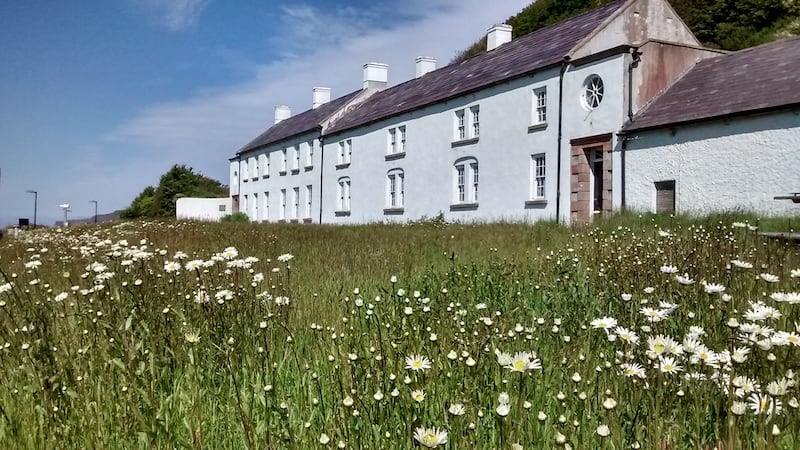A mythical spider, an upside-down lighthouse, puffins, lapwings and blue-eyed hares – for a little island off the northeast coast, Rathlin has a lot to love.
Neolithic axe-makers were attracted by its hard porcellanite and Bronze Age settlers from Spain as well as Vikings, Normans, Scottish chieftains and Irish smugglers have all left a mark on the L-shaped island, near the narrowest part of the waterway between its two larger neighbours.
It boasts many firsts: it was the location of the first Viking raid on Ireland, recorded in the Annals of Ulster; the site of the world's first commercial wireless telegraphy link between the island and Antrim's Ballycastle; and the first and unexpected landing point for Virgin group owner Richard Branson in 1987 after a transatlantic balloon flight, when he was rescued by the late ferryman, Tommy Cecil.

An early 14th century Scottish visitor’s experience appears to be more myth than fact. Although Robert the Bruce sought refuge on the island, there is now some doubt as to whether he was in a Rathlin cave when he was inspired by that persistent spider to pursue his battle for Scottish independence.
The island has three lighthouses, including one with a beacon built at ground level, as both rocks and fast-flowing tidal streams off the Causeway coast have created hundreds of shipwrecks.
It was often no safer onshore. At least three massacres were recorded on the island since Tudor times – and Sir Francis Drake had blood on his hands in regards to one of them.
The Gage family
At its peak, Rathlin’s population stood at 1,300 and it survived the famines of the 19th century. This was due in no small part to benevolent landlords, the Gage family, who brought a period of stability to the island after they bought it in 1746.
The Gages were never wealthy but had much ability, according to the late maritime writer and Rathlin historian Wallace Clark. Under their watch, the population expanded as it was protected from the turmoil of rebellions and agrarian difficulties on the mainland. Kelp production became one of many activities during the latter part of their tenure.
The Manor House, the Gage’s two-storey home on the pier, still stands overlooking Church Bay two centuries later, and is now the focus of a new appeal by the island – for someone to manage it as a three-star guesthouse.
Owned by the British National Trust, it had been leased in recent years as a guesthouse and a restaurant. In 2010 it made headlines for the wrong reasons, when a booking for Britain’s Prince Edward and his wife Sophie was cancelled at the last minute, and the royal couple were plied with sandwiches, sausage rolls and cake in nearby McCuaig’s Bar.
More recently, the Rathlin Development and Community Association opted to run it, and applied for a lease from the National Trust. The community has long recognised that tourism is a lifeline for the population of 140, and Rathlin’s visitors are of a special kind.
Nature reserve
The volcanic island is a Special Area of Conservation and a nature reserve for guillemots, fulmars, kittiwakes, razorbills and a fragile population of tiny sea parrots – the puffin colony run by the Royal Society for the Protection of Birds (RSPB). Rich marine life includes a new species of anemone. One of the lighthouses, Rathlin West, has been refurbished. It is among 12 coastal locations offering accommodation under the Great Lighthouses of Ireland tourism initiative run by the Commissioners of Irish Lights (CIL).
And so, the island’s community association applied to the British Crown Estate for a refurbishment grant for Manor House. Association chair Michael Cecil explains that the Coastal Communities Fund derives from revenue accrued from marine assets, including seabed licenses for oil production in British waters.
Some £750,000 (€965,000) was awarded, and design team Donnelly O’Neill was hired by a project board after it was put out to tender.
“We have had the 12 bedrooms refurbished, the kitchen relocated, and we hope to have it open as a three-star guest inn by mid-June,” Cecil says.
“And what we are looking for now is someone with experience in the industry who will run it for us all year round,” he says, pointing out that accommodation suitable for a young family is included in the offer.
Cecil says the Manor House post would suit a “management couple or individual looking for a new challenge, or indeed an operator with a small to medium chain of hotels and guest inns, looking to expand their portfolio.
“The Manor House guest inn is going to play a key role in developing a sustainable economy for Rathlin and so, if they have the right background, experience and energy, we don’t mind who it is,” he says.
The island appeal attracted several hundred “expressions of interest” before the closing date for applications on March 4th.
rathlincommunity.org


















